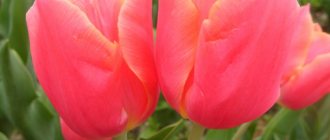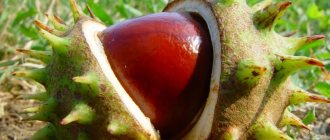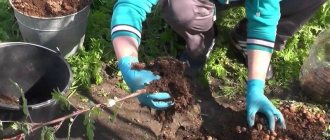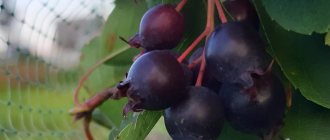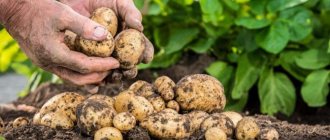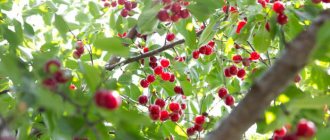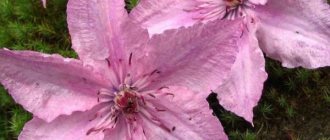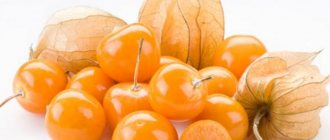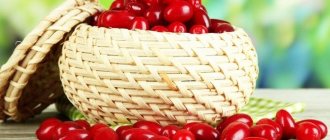Summer residents: the best materials about gardening October 22, 2019
Reproduction Photo by Sergei Yanin
A young bush similar to a bird cherry was bearing fruit on a neighbor’s property this season.
True, the berries were not as black as those of bird cherry, and were the size of cherries. The neighbor said that this is a hybrid of bird cherry and cherry. I gave him a handful of berries to try. They tasted almost non-astringent and actually had a cherry flavor. What kind of plant is this? The neighbor calls it "cherry bird." Oleg Nikolaevich SEMYASHKIN, summer resident
This plant has a scientific name - cerapadus. “Cherry bird cherry” owes its birth to Ivan Vladimirovich Michurin, a great Russian scientist, biologist and breeder. Having decided to provide cherries with stress resistance, Michurin introduced a winter hardiness gene into their heredity by crossing frozen cherries with Poppy bird cherry. The result was Cerapadus: cerasus is the Latin name for cherry, padus is for bird cherry.
Today this is no longer a new product on the market of planting material offered to gardeners by various nurseries. However, seedlings can also be found on sale under another name - padocerus. The only difference is that Cerapadus are obtained from the pollination of cherry flowers with bird cherry pollen. Padocerus, on the contrary, is obtained from the pollination of bird cherry flowers with cherry pollen. In other words, padoceruses are “palidromous” plants.
Related article:
For winter apartments. When do you need to remove indoor plants from the balcony?
The berry clusters of the hybrid resemble bird cherry, and the size of the fruit is that of a cherry. The Michurin cerapadus had from 3 to 6 fruits in the hands, 1 - 1.5 g each. The taste varies: from indigestible, literally cinchona-like, to relatively pleasant. But the original Michurin hybrids have long since disappeared.
In general, Michurin failed to bring the experiments with “cherry-cherry” to its logical conclusion. He only managed to predict that in the future cerapaduses will be able to compete with cherries thanks to the emergence of new independent species.
But scientists returned to the selection of cerapadus decades later, when a devastating fungal disease, coccomycosis, hit the cherry orchards.
Selection work led to the production of the first forms of cerapadus with completely edible fruits.
Plants are highly resistant to coccomycosis and winter hardy. And although they are inferior to cherries in terms of fruit quality, they are quite suitable for jam, compotes and other preparations.
The most popular varieties of cerapadus are Long-awaited and Novella. They are included in the state register of breeding achievements as “cherry,” but in fact they are nothing more than cerapadus. The Rusinka variety has also been created. In the Non-Black Earth Region, even after harsh winters, it can bear fruit annually with a yield of 8 - 10 kilograms of berries per tree. The fruits themselves are small - up to 3 grams, almost black, sweet and sour. But they can not only be processed, but also eaten fresh. There are also varieties Firebird, Korona, Aksamit.
Cerapadus blooms like ordinary bird cherry, but without the intoxicating aroma. The brush is twice the size of a bird cherry brush.
The plant can be formed as a low tree on a bare trunk. Or keep it in the form of a bush of two or three shoots, cutting off the top annually (late autumn or early spring) to a height of no higher than 2.5 meters. The desired bush width is 1.5 - 2 meters. It should not thicken and shade neighboring plants.
The aging thickening trunk of one of the shoots should be cut out after 6 - 7 years, giving it the growth of a young one in return. All thickened branches and trunk shoots from the ground with small growth and bare ones should be cut out in autumn or spring.
The plant is unpretentious to both soil and light - it can grow anywhere in a summer cottage.
Cerapadus can be propagated by seeds during autumn sowing, and by root suckers. The number of offspring increases due to the awakening of dormant buds on the chopped off roots.
In our online store you can purchase the second collection of the best tips for summer residents - “Vegetable garden. Autumn winter " . There you will find all the information on how to care for your site between September and February.
Share on VKontakte Facebook
Cool
The history of hybrids
At the beginning of hybridization, the breeder took steppe cherry and common bird cherry as a basis, but the result was negative. Michurin's next decision was to replace the common bird cherry with Japanese Maaka. Cross-pollination was carried out in two directions: cherry flowers were crossed with bird cherry pollen and vice versa. In both cases, a new stone fruit crop was obtained. The scientist gave the name according to the first syllables of the Latin designation of the species - cherry (cerasus), bird cherry (padus).
New hybrids were not immediately recognized as independent berry plants; they only partially inherited the characteristics of the founder species. Cerapadus and padocerus had a branched, well-developed root system, formed inflorescences and the number of fruits, like the parent varieties, and resisted diseases well. But the berries were bitter with an almond smell, small. The first generation of hybrids was subsequently used as a rootstock for breeding new varieties of cherries.
Landing rules
Cerapadus seedlings can be planted both in spring and in early autumn. The plant has sufficient winter hardiness and takes root well before the onset of winter cold. The technology for planting cerapadus is as follows:
- Seedlings planted in April take root best;
- for planting, a place well lit by the sun should be allocated without drafts or cold gusty winds;
- for cultivation, it is advisable to select an area with reaction-neutral soil with average or increased fertility indicators;
- if necessary, preliminary deep digging of the soil is carried out with the application of organic and mineral fertilizers, the composition and quantity of which may vary depending on the type of soil;
- planting pits for spring planting of berry seedlings should be prepared in the fall;
- the standard diameter of the planting hole should be approximately 70 cm with a depth of half a meter;
- the average distance between planting holes should not be less than 2.5-3 m, which will provide the nutritional area necessary for the plant;
- two buckets of well-rotted humus or manure with potassium and phosphate fertilizer should be poured into the bottom of the pit;
- Before planting, the root system of the seedling should be immersed in water to saturate the roots with moisture before planting.
After planting, the plant must be watered with two or three buckets of warm water, and then the tree trunk circle must be mulched with peat. The plant can be used as a very good rootstock for growing seedlings or as a skeleton-forming plant.
Distinctive features of hybrids
During long-term work on breeding a culture with a minimum number of defects, we got Cerapadus sweet. The berry plant inherited the Ideal fruits from the cherry:
- the shape of the berries of the hybrid of bird cherry and cherry is round, of medium volume;
- the peel is thin, dense, the flesh is dark red;
- surface – glossy, closer to black;
- taste – sweet and sour, well balanced.
From Maak the hybrid received a strong root system and frost resistance. Cerapadus has a strong immune system; thanks to bird cherry, the plant practically does not get sick and is not affected by pests.
A special feature of cerapadus and padocerus is the possibility of using them as a rootstock for less resistant varieties of cherries. The grafted varieties safely tolerate low temperatures, they are grown in regions with a temperate climate, and their range has spread far beyond the Central region of Russia.
Created on the basis of the first hybrids, cerapadus varieties not only have high frost resistance, they produce a high, stable yield of berries. The fruits are large and taste like cherry, with a slight aroma of bird cherry. A tree with many branches and shoots, the leaves are similar to cherry leaves, slightly oblong in shape. The plant forms a dense crown, pressed against the trunk, dome-shaped.
Later, padocerus cultivars were obtained with the appearance of bird cherry, the fruits are located in clusters, the berries are large, black, with a sweet cherry taste. They bloom in early spring, the flowers are not afraid of returning frosts.
Attention! Hybrids and varieties of Padocerus and Cerapadus, included in the State Register, are registered in the “Cherry” section.
Berries of a culture of universal use. Consumed fresh, used for making jam, compote, juice. The plant is unpretentious in care, self-fertile, most varieties do not require pollinators.
Advantages and disadvantages of dukes
The culture obtained by crossing bird cherry and cherry has a number of advantages:
- has a powerful root system;
- withstands low temperatures well;
- produces berries enriched with microelements and vitamins beneficial to the body;
- The taste of the fruits combines the sweetness of cherries and the aroma of bird cherry;
- hybrids are self-pollinating and always produce high yields;
- unpretentious in agricultural technology;
- resistant to infection, rarely affected by garden pests;
- serve as a strong rootstock for heat-loving cherry varieties.
No disadvantages were found in padocerus and cerapadus during cultivation.
Diseases and pests
Insects are not interested in both variants of bird cherry and cherry hybrids in principle. This is due to the fact that the culture is bred artificially and is not found in nature. Accordingly, pests are unfamiliar with the taste of its fruits and leaves and do not like it.
The practice of growing cherry and bird cherry hybrids indicates that individual insects periodically appear on trees. But, having tasted the leaves and berries, they quickly go in search of more “natural” food. Accordingly, even preventive treatments with insecticides are not necessary.
Almost all types of bird cherry and many varieties of cherries are very susceptible to fungal diseases. Both hybrids - Cerapadus and Padocerus - have much better immunity. The only disease noted by gardeners on trees is powdery mildew. But it also affects plants only when the weather is favorable for the development of pathogenic microflora for a long time - cold and rainy.
At an early stage of development, powdery mildew is a clearly visible layer of whitish-gray coating on the leaves, very similar to crumbled flour. Then it gradually thickens and changes color to brownish-brown. Affected tissues rot and holes form on the leaves.
Powdery mildew is dangerous for the vast majority of garden crops
To prevent powdery mildew (and other fungal diseases), you need preparations containing copper - fungicides. Hybrids of cherry and bird cherry, the soil in the tree trunk circle is cultivated at the beginning and end of the active growing season. If the weather favors the development of fungus, spraying is repeated monthly during the summer.
These same chemicals are used to combat the disease. But first you need to cut off all the leaves, even slightly affected by the disease.
Important! If there is less than a month left before harvesting hybrids of cherries and bird cherry, you can only use preparations of biological origin that are safe for health.
Cerapadus varieties
The photo shows hybrids of bird cherry and cherry, where the parent tree is cherry.
The most popular and widespread is Cerapadus Novella:
- tree height – up to 3 m, branched crown, intensively leafy;
- it is not affected by coccomycosis;
- has a well-developed root system;
- frost-resistant;
- the berries are large – up to 5 g, black with a glossy surface, grow singly or in groups of 2;
- The plant is self-fertile, pollinators are not needed.
The Novella variety is grown in the Central Black Earth region, Kursk and Lipetsk regions.
In memory of Levandovsky - grows in the form of a bush, up to 1.8 m high. The berries are large, sweet and sour, with a clear taste of bird cherry. The variety is not self-fertile; it requires the proximity of pollinating cherry varieties Subbotinskaya or Lyubskaya. The culture is frost-resistant and tolerates high temperatures well. Productivity is average, depends on the quality of pollination; weather conditions do not affect fruiting. The variety is new, bred for cultivation in the Northern regions.
Cerapadus Rusinka is a special cultivar for the Moscow region. The plant is a shrub up to 2 m tall, with a strong crown and powerful roots. Mid-early fruiting period. The yield is high due to the self-pollinating nature of the hybrid. The berries are medium in size, black, very aromatic. Sweet and sour with burgundy pulp. The bone comes off well. This hybrid is often grown commercially for cherry juice.
Care instructions
Cerapadus is less demanding on growing conditions and does not require additional measures to protect against fungal diseases. Agricultural technology includes the following activities:
- weeding tree trunk circles;
- feeding if necessary;
- carrying out formative and sanitary pruning;
- protection against plant parasites and diseases.
Cerapadus can be formed in the form of a trunk or multi-stemmed shrub. To lay the first tier, pruning is carried out at a height of 60–70 cm. Three or four of the most developed side shoots should be left. In subsequent years, tiers for the second and third orders are formed.
Sanitary pruning involves removing dry, diseased and broken branches . To protect against diseases and pests, spring spraying of the crown with Horus, 1% Bordeaux mixture, Planriz and Alirin-B is carried out. It is recommended to use Kinmiks and Fufanon as chemical insecticides.
Cerapadus is an excellent rootstock for heat-loving varieties and hybrid forms of cherries. The presence of a powerful root system, high resistance to cold winters, fairly rapid development and growth make the plant attractive to domestic gardeners and allow them to diversify their gardens with southern varieties of cherries.
Padocerus varieties
Hybrid varieties of Padocerus are not inferior to Cerapadus in varietal characteristics; many cultivars are even superior in taste. The most popular variety among gardeners is the Kharitonovsky variety, bred from the base hybrid Padocerus-M:
- The variety grows in the form of a tree, reaching a height of up to 3.5 m.
- Frost-resistant, tolerates temperatures down to -400 C.
- Mid-season, not self-fertile, requires pollinators.
- The fruits are bright red, the flesh is orange, the weight of the berries is up to 7 g, they grow solitary.
They are grown in the Voronezh, Tambov, Lipetsk regions, and in the Moscow region.
Firebird - padocerus grows in the form of a bush up to 2.5 m. The fruits are dark red, with the tartness of bird cherry, formed on a cluster. The average fruit size is up to 3.5 cm. The yield is high and resistant to infection. Frost resistance is average; the crop is not suitable for growing in temperate climates. Areas with warm climates are recommended.
Padocerus Corona is a young hybrid characterized by high productivity and frost resistance. The fruits are purple in color, located in a group on the cluster. The taste has a pronounced aroma of bird cherry and slight sourness. It grows in the form of a shrub, reaching a height of up to 2 m. The foliage is medium, the crown is loose. The plant does not get sick, it is not affected by pests. Regions of Central Russia are recommended for cultivation.
Varietal species of Padocerus
Padocerus hybrids are on par in terms of characteristics with cerapadus varieties; most varieties even have a better taste than cerapadus species. The Kharitonovsky variety is in greatest demand among summer residents; it was obtained from the basic hybrid variety Padocerus-M.
Description. The hybrid is presented in the form of a tree growing up to three and a half meters. It is resistant to frosty periods and can tolerate low temperature conditions down to minus forty degrees. Medium ripeness, not self-fertile, needs helpers for pollination.
The berries are deep red in color, the internal contents are orange, the fruit weighs up to seven grams, and grows singly.
Grown in Voronezh, Tambov, Lipetsk, Moscow and their regions.
Variety "Firebird". The plant is a bush that grows up to two and a half meters. The berries are dark red in color, tart, and are formed in a cluster. The average berry size is up to three and a half cm. The yield indicator is decent, the fruits are immune to infectious diseases. Resistance to frosty periods is expressed at an average level; it is not cultivated in temperate latitudes. Areas with warm climates are recommended.
Variety "Crown". A young hybrid crop that has a decent yield and resistance to frosty periods. The berries are purple in color and grow in groups on tassels. The taste is slightly sour, the aromatic properties are brightly reminiscent of bird cherry. It is a shrub that grows up to two meters. The plant is covered with moderate leaves, the crown is loose. The bush is immune to diseases and harmful insects. It is recommended to cultivate in central Russian latitudes.
Planting and caring for hybrids of bird cherry and cherry
The crop is propagated with seedlings purchased from specialized stores or reputable nurseries. The crop is rare, not often found in gardens, you need to be sure that you purchased exactly cerapadus, and not a similar fruit crop.
Important! Cerapadus can be grown for berries, used as a rootstock, or as a foundation plant for grafting several varieties.
Algorithm for planting seedlings
Cerapaduses and padoceruses can be placed on the site in the spring after the snow melts or in the fall 3 weeks before the onset of frost. The crop tolerates low temperatures well and is not in danger of freezing of the root system. Hybrids take root well due to their developed root system.
The planting site is determined in an area open to ultraviolet radiation, shading is not allowed, and the seedling is protected from the effects of cold wind. The soil is preferably neutral. Fertile or moderately fertile. Drainage does not play a role; the cerapadus has a root that penetrates deeply into the soil; the proximity of groundwater is not dangerous for the hybrid.
The planting hole is prepared 21 days before autumn planting. If planting material is planted in the spring (approximately in early April), then the pit is prepared in the fall. The holes are made of a standard size - 50*50 cm, depth - 40 cm. If group planting is planned, the root circle of an adult plant is about 2.5 m, seedlings are placed at intervals of 3 m from each other. Row spacing – up to 3.5 m.
Before planting, prepare a mixture of sand, peat and compost in equal proportions, add either potassium or phosphorus fertilizer - 100 g per 3 buckets of soil. Can be replaced with the same amount of nitrophoska. Before placing in the hole, the root of the hybrid is dipped in a solution that stimulates growth for 2 hours.
Sequencing:
- Pour 1/2 of the mixture into the bottom of the recess.
- They make a small hill out of it.
- Place the root on a hill and carefully distribute it.
- Fill with the second part of the mixture and compact so that there are no voids.
- They are filled to the top, the root collar should remain on the surface.
Water and mulch with a layer of straw or sawdust; do not use pine needles for mulch. Within 2 years the seedling gives a slight increase. This is the time of formation of the root system. The following year, the cerapadus grows rapidly and forms a crown. The tree begins to bear fruit in the 5th year.
Cerapadus care
This crop is undemanding to care, especially an adult tree. For young plants, loosen the soil and remove weeds when necessary. The basal shoots are very dense and require pruning. There is no need to water, the plant will have enough water received from precipitation; during the dry period, the young seedling is watered abundantly once every thirty days using the root method. Fertilizers are applied at the time of planting; no further feeding is required.
A procedure that is carried out without fail - the plant is treated with Bordeaux mixture before the juice flows in the spring season, the trunk is whitened in the autumn and spring seasons. The shrub is almost not susceptible to diseases and harmful insects. For preventive purposes or, if a disease is detected, the bush is treated with Actofit. There is no need to do anything else.
The bush-shaped hybrids we are considering are decorative when they bloom and bear fruit; in frequent cases they are used to create hedges.
The formation of the bush is carried out after three years. The standard of the tree is made up to sixty cm high, the skeletal branches remain on three tiers. The branches of the lower tier are longer, the next ones are shortened compared to the previous ones. The tree is formed early in the spring before the movement of sap begins or in the autumn season during the dormant period. In the spring season, old, dried branches are cut off. The crown is thinned out and the root shoots are cut off. In the autumn season, preparation for the winter season is not necessary, unless the root is covered with dry leaves or sawdust. There is no need to cover an adult plant.
Aftercare for hybrids
Cerapadus, like bird cherry and cherry, does not require special agricultural technology; the plant is unpretentious, especially in adults. The soil near the young seedlings is loosened and weeds are removed as necessary. The hybrid produces dense root shoots that need to be trimmed. Cerapadus does not require watering; seasonal precipitation is sufficient; in times of drought, a young tree needs intensive watering at the root once every 30 days. The seedlings are fertilized during planting; subsequent fertilizing is not necessary.
A mandatory procedure is to treat the hybrid with Bordeaux mixture before sap flow in the spring, and whitewash the trunk in the fall and spring. The hybrid practically does not get sick and is not affected by insects. For prevention or when problems are detected, the fruit crop is treated with the biological product "Actofit". No additional measures are required for the hybrid.
Advice! Bush-shaped cerapadus and padocerus have a decorative appearance during flowering and fruiting; hybrids are often used to create hedges.
The culture is formed after 3 years of growth. The tree trunk is formed up to 60 cm high, the skeletal branches are left on 3 tiers. The lower tier of the branch is longer, the subsequent ones are shorter than the previous ones. Formation is carried out in early spring before sap flow or in autumn, when the tree is dormant. In spring, old, dry branches are pruned. Thin out the crown and cut off the root shoots. By autumn, no preparatory measures are required, only the roots of the seedlings are covered with a layer of dry leaves or sawdust. For an adult tree, shelter is irrelevant.
Care and cultivation
Cerapadus, like its ancestors, does not require much care. It is enough to carry out several standard activities annually and from time to time provide the tree’s essential needs for water and nutrients.
Watering and fertilizing
Cerapadus has powerful roots that help it cope with temporary moisture deficits. Trees need watering during the first two years after planting. In the future, the hybrid does without artificial watering; it receives enough moisture from the rains.
Young trees are watered taking into account weather conditions. Focus on the condition of the soil - it should not dry out. As soon as the soil dries 2-3 cm deep, the cerapadus is watered. When the soil dries out a little, it is carefully loosened.
Cerapadus is fed three times during the season:
- early in spring add 1 tbsp. l. nitroammofoski – per one tree;
- during flowering, watering and loosening the soil in the circle around the trunk, add potassium sulfate and superphosphate - 10 g each;
- After harvesting, wood ash is added - 400 g per tree.
Fertilizers begin to be applied 2-3 years after planting. Until this time, the young tree has enough food stored in the planting hole.
Pruning and crown formation
With the help of formative pruning, cerapadus can become either a standard tree or a shrub - the choice depends on the characteristics of a particular variety.
Features of the formation of Cerapadus:
- To make the crop look like a bush, 3-4 powerful shoots are left, and the rest are cut to 0.7-0.8 m.
- When stamping, a trunk is made 0.6 m high. The crown is formed from 2-3 tiers, in each of which 3-4 skeletal branches are left.
Forming a crown is a complex procedure, so many summer residents do not engage in it, giving the tree the opportunity to grow as it pleases. If it receives good care, it will produce a rich harvest without formative pruning. But he cannot do without a sanitary procedure.
During sanitary pruning, branches are removed:
- dry;
- sick;
- deformed;
- damaged by diseases, frosts, pests;
- thickening the crown, and in shrub form - the above-ground part.
Hybrid propagation
Cerapadus is propagated in a simple and proven way - by trunk shoots. The hybrid, like the cherry, has plenty of them.
How to propagate Cerapadus by tree trunk shoots:
- Dig up the cutting.
- Transplant it into the prepared planting hole.
- If the soil is infertile, add fertilizer.
- Water the planted shoot.
The second method of propagating cerapadus is by cuttings. Planting material is harvested from plants that have entered the phase of maximum fruiting. The hybrid used to obtain cuttings must be at least five years old.
How to propagate a hybrid by cuttings:
- Cut planting material from the tops of young shoots. The approximate length of the cuttings is 8 cm.
- Place the chopped shoots in a nutritious soil mixture and place them in a shaded place.
- When the cuttings take root, transplant them to a permanent location.
What can be prepared from a hybrid of bird cherry and cherry?
Many varieties of the crop produce fruits that are sweet, juicy, aromatic, and are consumed fresh. No matter how tasty the berries are, they combine both cherries and bird cherry; not everyone likes their exotic taste. There are varieties of hybrids that produce fruits that are tart and bitter; their flavors disappear after heat treatment. Therefore, it is recommended to process the berries into juice, jam, preserves, and compote. You can make homemade wine or liqueur with herbs. Regardless of what the berries are processed into, the pit, which contains hydrocyanic acid, is first removed from it.
History of Cerapadus and Padocerus
Cerapadus and padocerus did not immediately enter the family of fruit crops. The first hybrids only partially combined maternal and paternal properties: they acquired a powerful root system, high frost resistance, increased resistance to coccomycosis, gum disease, and a number of other diseases, and an inflorescence shape (from 1-2 flowers to a raceme with 4-6 fruits). However, the fruits of Cerapadus No. 1 were of unpalatable taste. Their taste was sometimes quinine-bitter or bitter almond with the smell of hydrocyanic acid. Cerapadus fruits were formed in large numbers, but small. New varietal hybrids obtained good rooting of cuttings during vegetative propagation. In breeding work they began to be used as an excellent rootstock material for cherries, sweet cherries, and plums.
Description and characteristics
The hybrid variety obtained by crossing bird cherry and cherry is usually called cerapadus. The name was obtained by adding the Latin names of the plant's progenitors. The pioneer of breeding plants was Michurin I.V., and as a result of numerous experiments, modern varieties acquired the qualities of winter hardiness of bird cherry.
The peculiarity of cerapadus fruits is that the leaf blades resemble the shape of cherry leaves, and the berries are a hybrid in appearance and taste. The first type of unusual plant bred was distinguished by the sugar content of the berries and the unusual, almost black color of the fruits.
Modern varieties have a dense crown and are characterized by a decent size of green mass.
The advantages of cerapadus were the following:
- high frost resistance;
- well developed root system;
- high productivity;
- large berry shape;
- decent external and taste quality of berries;
- resistance to diseases, especially coccomycosis.
Today the list of cerapaduses is quite wide. Some varieties form racemose inflorescences, which allows for high yield.
The best varieties
Hybrids of cherries and bird cherry today include a large number of varieties. The distinctive quality of any of them is their high ability to tolerate low temperatures, which is why they are grown in regions with cold climates.
The following varieties have gained popularity among Russian gardeners:
- Cepadus Novella is a tree-like tree that can reach a height of 3 m and does not require pollinators;
- Rusinka - shaped like a bush, the height of which does not exceed 2 m;
- Lewandowski's memory is a bushy species, classified as a self-sterile variety, and therefore requires pollinators for fruiting.
Read also How long to cook blue leg mushrooms before frying
In Russian regions, cerapaduses have not yet found wide distribution, since not everyone likes the presence of a hint of bird cherry in the fruits. Moreover, they are often used as a rootstock for cherries, bird cherry and plum crops.
History of hybrid breeding
Before the hybrid was bred by I.V. Michurin, it has not been found in the wild. This scientist decided to crossbreed bird cherry and cherry. Numerous attempts have been made to cross-pollinate different plant species, but a successful attempt was the crossing of the Japanese Maaka bird cherry and the Ideal steppe cherry.
In this case, two types of hybrids were obtained:
- Bird cherry pollen was transferred to the cherry pistil. The resulting hybrid was named Cerapadus.
- The variety obtained when cherry pollen gets on the pistil of a bird cherry flower is called Padocerus.
The names chosen are related to the Latin names for bird cherry and cherry: Padus and Cerasus.
However, when creating hybrids at first, the new variety did not inherit all the important properties of its parents. It gained resistance to winter cold, a strong root system, and resistance to some diseases. However, the taste was not good enough. The berry harvest was large, but the fruits themselves were too small.
The created hybrids have become a good rootstock for sweet cherries.
Later, from the first varieties of cerapadus, those that combined good taste, high yield, strong root system, winter hardiness and other advantages were obtained.
What and for what?
There are dozens of grafting methods, and they solve a lot of different problems, from restoring dying bark to a collection of varieties on one tree. In all the splendor of their diversity, they are described in textbooks and manuals. Apparently, it is for this reason that most summer residents do not even think about trying to graft something, confident in the incomprehensibility of this “art”.
I'm not much of a vaccinator either. At the academy we were taught only to bud - to implant a bud (peephole - “eye”) under the bark of a seedling. True, we were taught how to sharpen a knife and were given a little training on how to hold it: if you cut yourself, you won’t get credit. But that was a long time ago, and I wanted to vaccinate now. I began to try and observe. Then I tried to highlight the main meaning of this technique in relation to our dachas. And this is what we came to: we need a grafting method that allows a person without knowledge and skill to turn one tree into another in one fell swoop, and so that this other tree quickly, in two years, grows and begins to bear fruit.
This is exactly the method I will describe in full detail. Try it and you will see: vaccination is a very simple procedure.
First of all: young shoots (end growth) on a young and healthy tree (or branch, or branch).
It is better to cut shoots for the scion from the southern side of the crown and from the branches of the middle tier: on the lower ones the growth is too small, and on the top it is too thick and powerful. Better cuttings are half or two-thirds of a pencil thick.
The best rootstock is a young healthy tree, root scion or seedling, or even a sapling, with a trunk thickness of 3–10 cm. If the rootstock is sick or has weakened growth, there is no point in grafting, except perhaps for training. Healthy, strong branches of a mature tree that have the specified thickness are also suitable.
And now about breed compatibility. In Bulgaria, currants are grafted onto cherries. And Michurin grafted a pear onto a lemon. In fact, using special methods, it is apparently possible to graft an orange onto a birch tree. It’s not clear why, though. Well, if only out of interest! Although, it must be said that the rootstock can greatly change the properties of the scion. Michurin even talked about somatic hybrids, and for good reason. Indeed, new common properties appear, but over time, one of the “cohabitants” begins to subjugate the other: the one who is genetically younger, taken at a younger stage, found himself in atypical conditions or exposed to stress. I read that somatic hybrids were produced at the seed stage by grafting parts of the cotyledons of completely different seeds. They wrote that various amazing chimeras grew up. Researching this is exciting, but we need options that guarantee compatibility even with low grafting techniques.
CHERRY CHRISM is the strongest and most fertile rootstock for all stone fruits, except cherries and sweet cherries. Most stone fruits are grafted onto it. Both offspring, shoots under the trunk, and seedlings of wild cherry plum can be found everywhere and are easy to recognize: powerful growth, small leaves, yellowish-ocher young bark.
PLUMS, especially semi-wild ones - suckers and seedlings - are not so powerful, but are also suitable for all the mentioned stone fruits.
APRICOTS and PEACHES purchased as varietal seedlings, as a rule, are already too sick by the age of three or four years, and their wood is affected by tinder fungus. Seedlings are stronger and healthier, but they take root well only when they are young, before the bark becomes rough. It is better to graft into the base of branches. But I wouldn't get involved.
All of the above can be vaccinated on them.
CHERRIES AND CHERRIES are often grafted onto wild cherries or antipka, similar to bird cherries. All of the above, including bird cherry, are compatible with each other. The most accessible material for rootstock is cherry scions. The optimal thickness is 4–7 cm. Their advantage is that they are healthy and powerful.
APPLE TREE accepts apple and pear trees well, and cuttings can be grafted under the bark even at the end of summer.
PEAR accepts the apple tree with difficulty, but easily accepts only its own pear relatives. Moreover, it is grafted onto apple trees, quince trees, rowan trees and hawthorns. This is not even nationalism, but chauvinism! It is justified by the fact that it easily forms its own roots during air layering.
QUINCE is a rootstock for itself and for the pear. The pear is “picking up”.
The most likely rootstocks for us: cherry plum, cherry, apple and pear trees
Pay attention to them first of all in the garden. Let me remind you: they do not need to be replanted, the more powerful the growth, the faster the new tree will grow
In any case, first graft and let it grow, and only then replant - in a year or two.
Even in the above options, not all varieties are equally compatible. Therefore, it is reasonable to graft several varieties onto the rootstock at once - something will take root.
Agricultural technology
There are no big problems with planting and caring for the tree - it is quite unpretentious. However, some nuances still exist - we will consider them below.
You will be interested to learn about cherry propagation methods.
Selecting a location
The place for planting the seedling is chosen to be open, sunny and on soil with neutral acidity. Here the new plant will take root well and begin to grow. It is undesirable to have fences nearby so that air flows are not obstructed. The occurrence of groundwater should not be higher than one meter from the surface, so that the bulk of the roots are not subject to constant moisture.
Landing
The landing order is as follows:
- 2-3 weeks before autumn planting, in the chosen place you need to dig a hole 70 cm deep and the same diameter (for spring planting, the hole is made in the fall).
- The pit is watered, 1-2 buckets of organic fertilizers (manure, bird droppings) are added there.
- The seedling is placed with its roots in clean water 10 hours before planting.
- The plant is planted in the morning or evening, while the roots are straightened and the trunk is installed in a vertical direction.
- A previously dug clod of earth is sprinkled onto the roots of the plant and compacted a little with garden tools.
- After this, the seedling is watered with a bucket of water.
When preparing holes, it is taken into account that there should be about three meters between plants. To plant a garden, this distance should be maintained both along the bed and between the rows.
Important! It is necessary to ensure that the root collar of the trunk protrudes above the soil by 2
–
3 cm: this will allow the plant to take root better.
Watering, fertilizing
It is necessary to water the plant when the circle of soil around the standard dries out to a depth of 2–3 cm. In this case, abundant watering is carried out, and after the soil has completely absorbed and dried out, this place can be loosened.
The plant in question is unpretentious and does not require a special feeding regime . Phosphorus and potassium fertilizers can be applied 2-3 years after planting: during this time, the fertilizer is absorbed and washed out of the planting hole.
We advise you to learn about the features and methods of feeding cherries.
Weeding around the trunk helps the tree's roots receive more nutrition from the ground , so it is necessary to remove all excess plants around the crop once every two weeks.
Pruning and crown formation
Depending on the variety, cerapadus forms as a standard tree or a bush in the form of a wild bush cherry. Usually, a few of the most powerful shoots (3-4) are left, and the rest are shortened to a length of 70–80 cm. When stamping, a trunk of about 60 cm and a conical crown of 2-3 tiers are made.
This is a rather complicated operation, so most summer residents let growth take its course. But with quality care, the tree will reward you not only with its excellent appearance, but also with a good harvest.
Did you know? Cerapadus and the apple tree growing nearby are not competitors. Root secretions from root suckers help these two plants in terms of growth and health.
Crown formation is an important process, but sanitary tree pruning is much more important. In early spring, while the sap in the branches is dormant, diseased, broken branches growing inside the crown or bush are removed. This is done with sharp pruning shears, and the branches are taken outside the garden and burned.
Disease and pest control
Pests avoid the described plant, since it is a hybrid . Sometimes you come across some insects that quickly realize that this tree is not to their liking and leave.
But to avoid such attacks, you can carry out prevention by spraying the plant in April with Bordeaux mixture in a ratio of 1% to water. During the growing season, you can treat the crown and the ground underneath it with preparations such as “Actofit”, “Planriz” and the like.
Reproduction of a hybrid of bird cherry and cherry
The propagation of the hybrid is carried out in the same way as with an ordinary cherry - the trunk shoots are taken from a profusely flowering and fruit-bearing tree. They are dug up, rooted in a new place and subject to high-quality care. The new seedling is placed in the soil and watered. You can apply fertilizer in advance, but this is not necessary.
Learn how to grow cherries from cuttings.
A hybrid of bird cherry and cherry is an extremely interesting crop invented by man. Its fruits can have a very different taste - from sour bird cherry to sugary cherry.
